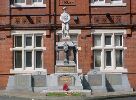
Newton-le-Willows and
Earlestown War Memorial

| OTHER WARS |
 |
Newton-le-Willows andEarlestown War Memorial |
 |
| The
Great War Roll of Honour |
|||||||||||||||||||||||||

Private George Phythian was born and raised in Newton-le-Willows.
He lived with his parents at London Row, Vulcan Cottages, Earlestown. According
to the "Newton and Earlestown Guardian" issue of 8th October 1915,
they lived at number 8, while the Commonwealth War Graves Commission states
that his mother, Mrs. W. Phythian, lived at number 2 - at least after the
war, when their register was compiled. In the same way, George's age was given
in the Guardian as 22, but the CWGC gives his age as 23.
George joined the Warrington Territorials at the outbreak of war, and, after
training at Dunfermline and Tunbridge Wells, landed at Le Havre on the 13th
February 1915. Before the war he was a coppersmith at the Vulcan Foundry.
News of his death came in a letter from Company-Quartermaster-Sergeant Herbert
H. Bottomley, C Company, who said that George was killed in action by a shell
which exploded near him. He added that "he was a brave and good soldier.
His job was that of a 'bomber', a job requiring bravery and nerve-both of
which qualities Phythian possessed."
The obituary also included three other letters from George's comrades. Corporal
J. Whittaker wrote: "We made an attack on the German lines about 4 a.m..
We got into the first line and were advancing on the second, when a shell
burst close by and killed George instantly."
George's name is on the Menin Gate
at Ieper, the memorial to over 54,000 officers and men who died in the Ypres
Salient before 16th August 1917 and who have no known grave.
Captain Whalley-Kelly, in his book "Ich Dien", describes an action
in which George could have been involved, and the life of the battalion during
the months of August and September, 1915:
"[The Battalion] remained in the [Ypres] Salient, in the Hooge area,
until 23rd July, when it was appointed the Pioneer Battalion of the 3rd Division
and was based on Dickebusch. Before leaving the Hooge sector the bombers and
machine gunners took part in an attack on Sanctuary Wood delivered on the
23rd by troops of the 3rd Division. The detachment furnished by the Battalion
suffered heavy loss, only 27 bombers returning out of the 49 engaged.
"For the next two months the Battalion, in its new capacity, had a very
busy time digging and reconstructing trenches, road making and improving camps,
but the machine gunners and bombers continued to carry out tours in the front
line with units of the 7th Brigade. Also pioneer work itself, carried out
mainly at night, was extremely trying and often hazardous, requiring quite
as much soldierly spirit as any other of the multifarious tasks which the
British Army was called upon to perform at this time."
On the 25th September 1915, the 7th Brigade of 3rd Division, which included
the 2nd Battalion of the South Lancashire Regiment, were involved in the Second
Attack on Bellewaarde, part of the Battle of Loos. Captain Whalley-Kelly gives
an account of this attack,
basing it on the regimental diary. It is also described in a
'sensational' letter sent from the front by Private J. E. Garvey and published
in the Guardian of 1st October 1915.